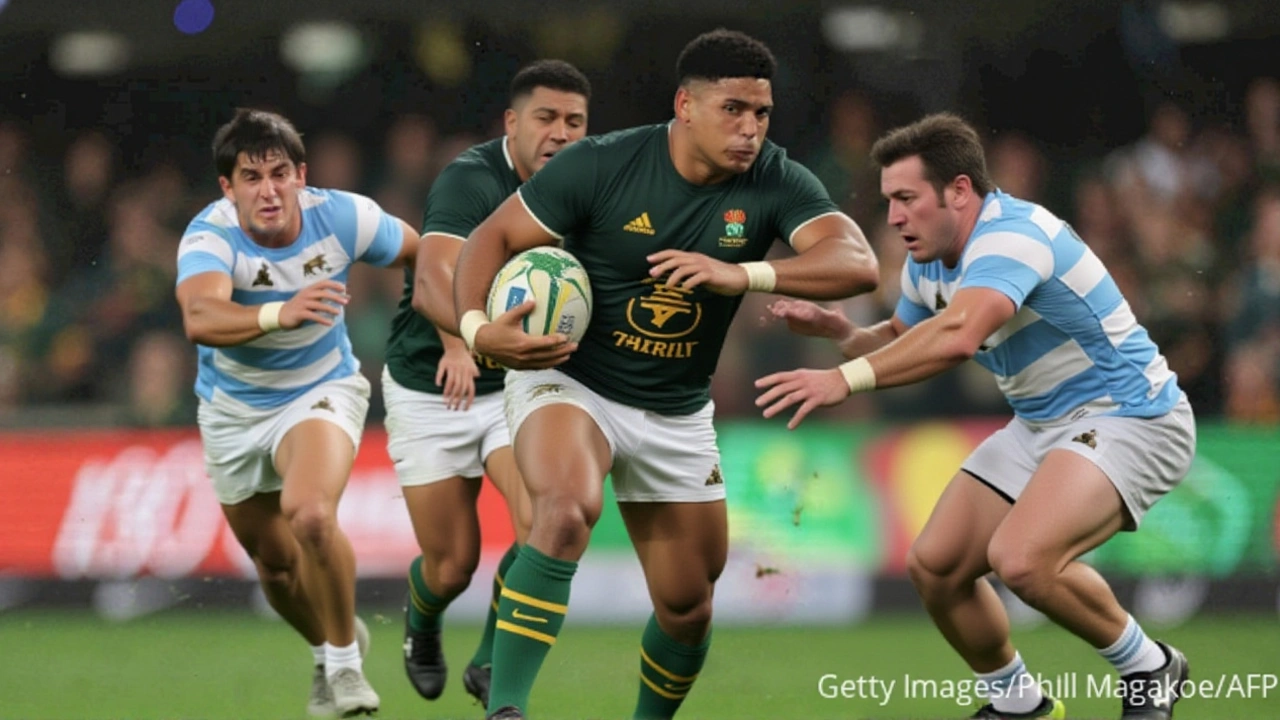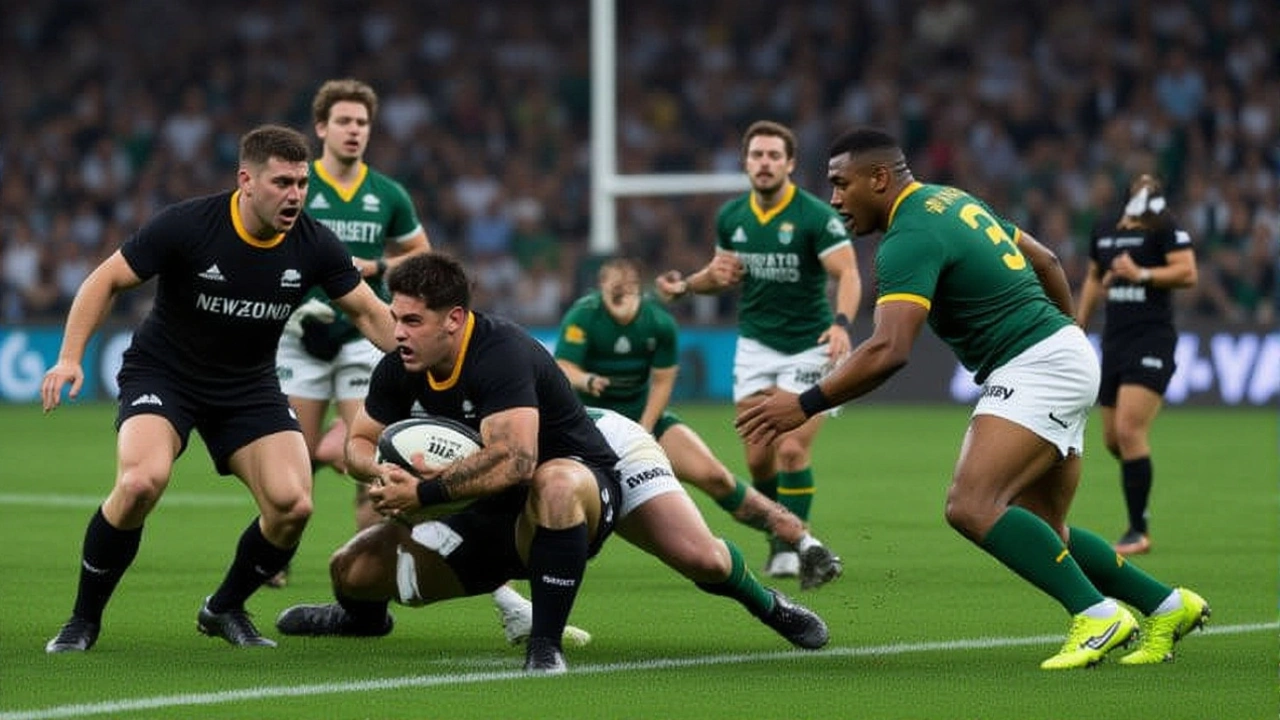When South Africa edged out Argentina 29‑27 at London’s Twickenham Stadium on October 4, 2025, the Rugby Championship title slipped through New Zealand’s fingers for the first time in a decade. The win handed the Springboks their second straight championship, shaving a razor‑thin points‑difference margin over the All Blacks, who finished equal on points but trailing by +57 to +8.
Final day showdown: New Zealand vs Australia, Argentina vs South Africa
The opening act of the day saw the All Blacks take on the Wallabies at 10:45 am BST. New Zealand powered through a disciplined comeback, handing Australia a 28‑14 defeat. Coach Ian Foster, who had been under fire after a string of narrow losses, praised his squad’s “late‑game grit.”
“We knew we had to finish strong,” Foster said in the post‑match interview. “The boys showed the character we expect from a champion‑contending side.”
Meanwhile, the second match, kicking off at 2:00 pm BST, turned into a nail‑biter. South Africa, led by veteran captain Siyepsilon Ntlaza, fell behind early but rallied after a pivotal try by winger Lukhanyo Am. Argentina, under coach Felipe Contepomi, matched every Kangaroo stride, forcing a tense finish.
In the dying minutes, a successful penalty from South Africa’s fly‑half sealed a two‑point margin. “It was a test of nerves,” Am reflected. “Every tackle, every kick mattered.”
How points difference decided the championship
Both New Zealand and South Africa finished the tournament with 19 competition points. The tie‑breaker? Cumulative points difference – a stat that often lurks in the background until a season ends on a cliffhanger.
- South Africa’s points difference: +57
- New Zealand’s points difference: +8
- Australia ended with 11 points, third place.
- Argentina, despite the close loss, slipped to fourth with 10 points, earning the wooden spoon.
The disparity largely stemmed from the All Blacks’ earlier 28‑14 loss to Australia in 2023 and a modest victory margin against the Wallabies this year. South Africa, by contrast, secured a 31‑12 win over Japan in June and kept each match within a tight margin, amassing a healthy +57.
“Points difference is the unsung hero of a league,” noted rugby analyst James Whitaker. “It rewards consistency, not just headline‑grabbing wins.”
Twickenham Stadium: A surprise venue for the Southern Hemisphere
Holding a Rugby Championship match in London was a novelty that sparked both curiosity and logistical chatter. This was only the second time the competition left its usual southern‑hemisphere venues, the first being the 2016 Argentina vs Australia clash.
The decision, announced by World Rugby in early 2025, aimed to tap into the growing fan base in the UK while offering a neutral ground for the final showdown.
Fans lined the historic stands, chanting in both English and Afrikaans, creating a unique atmosphere. “Playing at Twickenham felt like stepping onto a stage,” said Springbok lock Eben Etzebeth. “The crowd energy was electric, even if they weren’t all South African supporters.”
Nevertheless, the venue raised questions about travel fatigue and fairness. The All Blacks had to fly from New Zealand to London just hours after their victory over Australia, a schedule that some critics argued disadvantaged them.
What the result means for the Rugby Championship's future
South Africa’s back‑to‑back triumph cements their status as the dominant force in the southern‑hemisphere’s premier competition. For New Zealand, the outcome is a harsh reminder that historic dominance isn’t guaranteed.
Coach Foster hinted at a possible overhaul: “We’ll be looking at our structures, our set‑pieces – everything. The margin tells us we’re close, but not close enough.”
Meanwhile, World Rugby confirmed that the 2026 edition will shift to a biennial format, introducing the newly minted Nations ChampionshipVarious Southern Hemisphere venues. The move is intended to reduce player burnout and align the competition with the global rugby calendar.
Analysts predict that the longer gap will amplify the stakes of each match, making points difference even more critical.

Historical context and the shift to a biennial format
Since its inception in 1996, the Rugby Championship (formerly the Tri‑Nations) has been a yearly barometer of southern‑hemisphere rugby health. New Zealand has claimed the crown 15 times, South Africa 9, and Australia 2.
The 2025 edition will be remembered not just for its dramatic finish, but also as a bridge to a new era. The Nations Championship, slated to debut in 2026, will feature the same four core nations plus two invited sides, expanding the competitive pool.
“It’s a natural evolution,” said David Nucifora, World Rugby’s senior vice‑president. “We want to keep the Championship relevant while giving emerging nations a platform.”
Fans, however, are divided. Traditionalists mourn the loss of an annual clash, while younger supporters welcome the promise of fresh narratives and longer preparation periods.
Key takeaways
- South Africa wins the 2025 Rugby Championship on points difference.
- New Zealand finishes second despite a win over Australia.
- Twickenham hosts its second southern‑hemisphere match, highlighting the sport’s global reach.
- The competition will shift to a biennial schedule starting 2026, introducing the Nations Championship.
- Coaches from all four sides promise strategic overhauls ahead of the next cycle.
Frequently Asked Questions
Why did South Africa win the championship despite equal points with New Zealand?
Both teams ended the season with 19 competition points, but South Africa held a superior points‑difference of +57 compared to New Zealand’s +8. The tie‑breaker rule, applied uniformly across the tournament, gave the Springboks the edge.
What made Twickenham a chosen venue for the Argentina‑South Africa match?
World Rugby aimed to broaden the competition’s audience and test a neutral location. Twickenham’s capacity, historic prestige, and logistical infrastructure made it an attractive option, marking only the second time the Championship left the Southern Hemisphere.
How will the shift to a biennial format affect the teams?
A two‑year cycle gives nations more time for player recovery, strategic planning, and integrating new talent. However, each match will carry heightened pressure, as fewer games mean points difference could decide championships more often.
Who were the standout performers in the final day matches?
For South Africa, Lukhanyo Am’s decisive try and Siyepsilon Ntlaza’s leadership shone. New Zealand’s Dan Hodgson (fly‑half) and Sam u Moeaki (centre) were pivotal in the 28‑14 win over Australia. Argentina’s scrum‑half Tomás Lego displayed resilience despite the narrow loss.
What does this result mean for New Zealand’s future campaigns?
The All Blacks will likely reassess their attacking structures and defensive setups. Coach Ian Foster hinted at squad rotations and a deeper focus on set‑piece efficiency to close the points‑difference gap in the next tournament.


